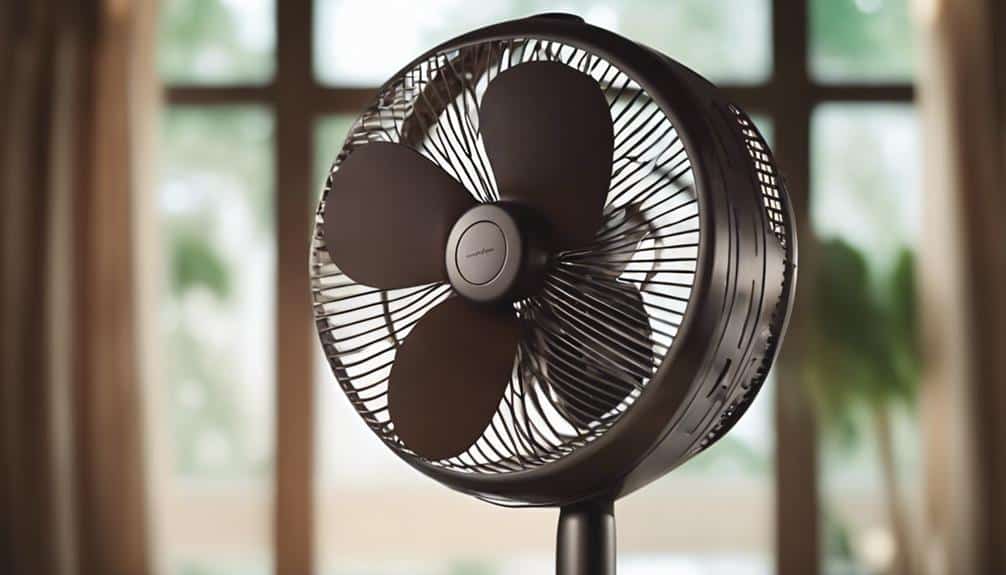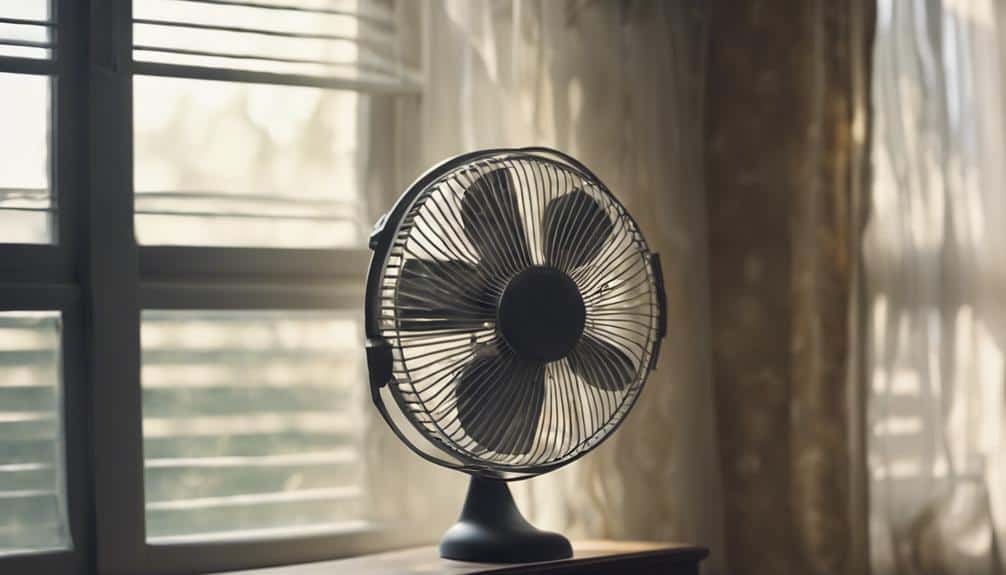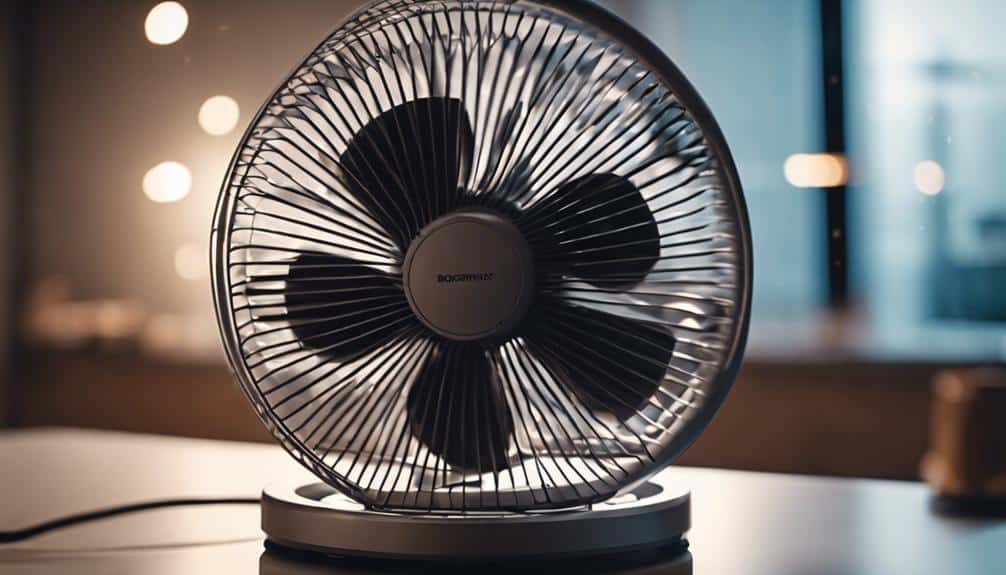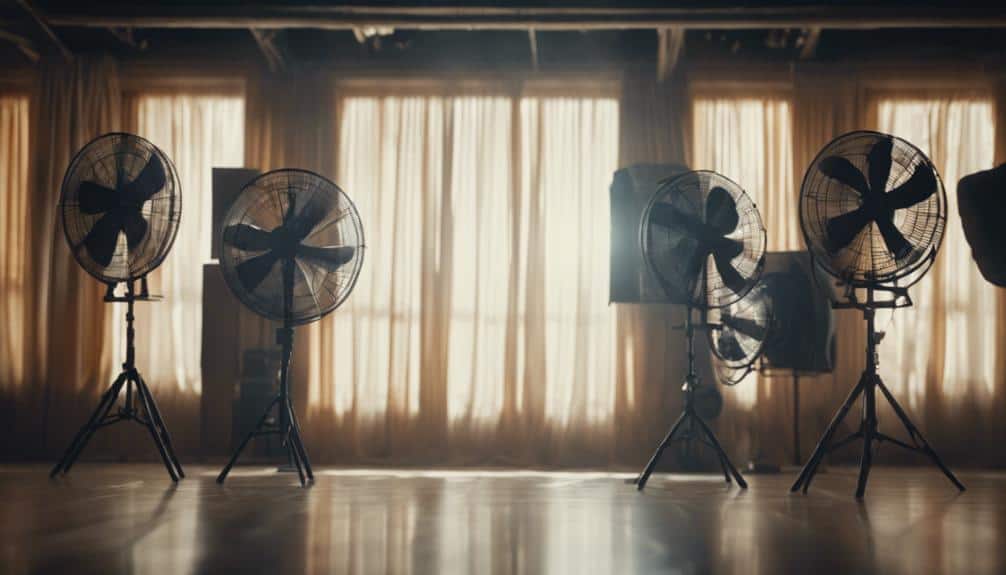7 Tips to Cool Your Room With Fans Efficiently
When it comes to keeping our rooms cool, fans can be our trusty allies in the battle against the heat. However, there’s more to it than just turning them on and hoping for the best.
What if I told you there are seven smart tips to make your fans work more efficiently, ensuring a cooler and more comfortable living space? Let’s uncover these practical strategies that will help you beat the heat without breaking a sweat.
Optimize Fan Placement
To effectively optimize fan placement for efficient cooling, angle the fans strategically to maximize air circulation and create a comfortable room temperature balance. When it comes to ceiling fans, positioning them to push air downwards during warmer months can help cool a room by creating a gentle breeze that aids in evaporation from the skin, providing a cooling effect.
The angle of the fan blades is vital in determining the direction of airflow; adjusting them to a steeper angle can enhance the circulation of air in the room. By directing the airflow towards walls, cooler air can be evenly distributed, preventing any hotspots and promoting a consistent room temperature.
It’s important to note that ceiling fans are more effective at cooling when set to rotate counterclockwise during warm weather. Proper fan placement not only helps in efficient cooling but also contributes to maintaining a pleasant and balanced room temperature.
Use Box Fans Strategically
Positioning box fans strategically is key to optimizing airflow and maximizing cooling efficiency in a room.
Placing fans near windows allows for the intake of cooler outdoor air while expelling hot air from indoors effectively.
Utilizing multiple box fans to create a cross-breeze can enhance cooling in larger areas by promoting air circulation.
Fan Placement Tips
Strategically placing box fans in your room can greatly enhance airflow and improve overall cooling efficiency. To optimize the cooling effect, consider the following fan placement tips:
- Window Placement: Position box fans in windows to draw in cool outside air and expel hot indoor air effectively.
- Floor Positioning: Place box fans on the floor to circulate air upwards, promoting efficient cooling throughout the room.
- Cross-Ventilation: Use box fans strategically to create cross-ventilation by positioning them near doorways to push hot air out and maintain a comfortable room temperature.
Airflow Direction Importance
Efficiently utilizing box fans involves strategically adjusting their airflow direction to optimize cooling effectiveness and maintain a comfortable room temperature. By drawing cool air into the room from open windows and expelling hot air, box fans can create a cross breeze effect that circulates fresh air and promotes efficient cooling.
Remember, hot air rises, so angling box fans towards the ceiling helps push warm air out of the room, improving ventilation. Placing box fans near doorways or windows aids in the intake of cool air and the expulsion of warm air, optimizing airflow circulation.
Adjusting the direction of box fans based on indoor temperature changes maximizes their cooling benefits, enhancing overall comfort and creating a more pleasant environment.
Leverage Ceiling Fans Properly

Let’s explore how adjusting the direction of ceiling fan rotation can optimize air circulation in the room.
By fine-tuning the fan speed, we can control the amount of air movement to match our comfort needs.
Utilizing the ceiling fan during cooler nights can help maintain a consistent temperature without overworking the air conditioning system.
Ceiling Fan Direction
To optimize cooling efficiency, adjust your ceiling fan blades to rotate counterclockwise during the warmer months. This direction creates a breeze effect, enhancing air circulation and promoting a cooler environment. Here are three key points to take into account:
- Energy Saving: Rotating the ceiling fan counterclockwise allows for better air circulation, reducing the reliance on air conditioning and ultimately saving energy.
- Cooling Efficiency: Angling the fan blades slightly upward can produce a heat-lifting breeze, improving overall cooling efficiency in the room.
- Maintenance: Regularly clean the ceiling fan blades when changing their direction to make sure of peak performance and cleanliness, enhancing the fan’s effectiveness in cooling the room.
Adjust Fan Speed
Adjusting the ceiling fan speed plays an important role in optimizing air circulation and enhancing cooling efficiency within a room.
To maximize the cooling power of a ceiling fan, higher speeds are recommended on hotter days, creating a stronger breeze for effective temperature control.
Conversely, lower fan speeds are more suitable for milder temperatures, ensuring a comfortable airflow without excessive cooling.
By utilizing the fan’s speed settings, one can customize the airflow based on personal comfort preferences.
Proper adjustment of the fan speed is key for efficient air movement, which contributes greatly to maintaining an ideal room temperature.
Mastering the fan speed settings on a ceiling fan is key to achieving efficient cooling and ensuring a pleasant environment.
Use Fan at Night
Maximizing the cooling potential of a room can be achieved efficiently by strategically utilizing ceiling fans, particularly at night to optimize airflow and enhance comfort. When it comes to using ceiling fans at night, here are three key points to take into account:
- Lower Room Temperatures: Ceiling fans can help lower room temperatures by up to 10 degrees Fahrenheit, providing a more comfortable environment for sleeping.
- Wind-Chill Effect: Running a ceiling fan at night can create a wind-chill effect, making you feel cooler without necessarily lowering the room temperature, aiding in a restful sleep.
- Counterclockwise Rotation: Adjusting the ceiling fan to rotate counterclockwise in the summer pushes cool air down, creating an invigorating breeze that enhances your comfort throughout the night.
Utilize Window Fans Effectively

Strategically positioning window fans can effectively create a cross-breeze in the room, optimizing airflow for efficient cooling. To achieve this, place one fan facing inward to draw in cooler outside air and another fan facing outward to expel hot indoor air. This setup promotes air circulation, helping to maintain a comfortable temperature without relying on air conditioning.
For best results, keep windows open during the evening when the air is cooler to maximize the cross-breeze effect and enhance ventilation. By utilizing window fans in this manner, you can reduce indoor humidity levels and improve overall air quality in your living space.
These fans play an important role in facilitating air movement, which is essential for creating a cool and invigorating environment. Embracing the use of window fans not only promotes energy efficiency but also contributes to a more pleasant and enjoyable atmosphere within your room.
Employ the Ice Fan Trick
Placing a bucket of ice in front of a fan can effectively transform it into a homemade AC unit, chilling the air as it circulates. By following this simple technique, you can cool your room efficiently without breaking the bank.
Here are three key points to bear in mind when employing the ice fan trick:
- Enhanced Cooling: The ice fan trick boosts the cooling capacity of your fan by lowering the temperature of the airflow. As the fan blows air over the ice, it picks up the coldness from the melting ice, resulting in a invigorating breeze that helps cool down your room.
- Cost-Effective Cooling: This method offers a budget-friendly way to combat the heat during a heatwave. Instead of investing in expensive air conditioning units, using ice with a fan provides a practical alternative that can effectively lower the room temperature.
- Simple and Efficient: Experts at the Good Housekeeping Institute recommend the ice fan trick for its simplicity and effectiveness in maintaining a cooler indoor environment. It’s a straightforward yet powerful method to beat the heat and stay comfortable in your room.
Consider Tower Fans for Efficiency

Tower fans are a practical choice for efficiently cooling rooms with limited space due to their slim and tall design. Their ability to provide widespread oscillating air circulation makes them ideal for larger areas.
To enhance their cooling efficiency, consider placing a second fan near the tower fan to help distribute the cool air more effectively. Another tip is to place a bowl of ice in front of the tower fan. As the fan blows air over the ice, it creates a cooler breeze in the room.
Additionally, if the air outside is cooler in the evenings, position the tower fan near an open window to bring in the fresh air and push hot air out. For a quick cooling boost, you can also place a wet towel in front of the tower fan or use a floor fan in conjunction with the tower fan to increase air circulation.
Combine Fans for Maximum Cooling
To maximize cooling efficiency, consider combining multiple fans to create a cross-breeze effect in the room. By strategically placing two fans in opposite windows, you can effectively circulate cooler air throughout the space. Here’s how to make the most of using two fans to cool your room efficiently:
- Position Fans Opposite Each Other: Place one fan in a window on one side of the room and another fan in a window on the opposite side. This setup allows for the best airflow and the creation of a cross-breeze effect.
- Direct Airflow Across the Room: Angle the fans so that the airflow from both fans meets in the center of the room. This technique helps to distribute the cooler air evenly and lower the room temperature quickly.
- Utilize Both Fans Simultaneously: Run both fans at the same time to make sure that the cool air is continually circulating throughout the entire room. This method accelerates the cooling process, creating a comfortable indoor environment even on hot days.
Conclusion
To sum up, by strategically placing and utilizing fans in conjunction with open windows, you can efficiently cool your room during warm weather. Remember to create a crosswind by positioning one fan to intake cool air and another to exhaust hot air, optimizing airflow circulation.
With the right fan placement and techniques, you can effectively maintain a cooler temperature in your room without the need for expensive cooling systems.






